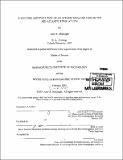| dc.contributor.advisor | Brian Tucholke. | en_US |
| dc.contributor.author | McKnight, Amy R. (Amy Ruth), 1975- | en_US |
| dc.contributor.other | Joint Program in Oceanography. | en_US |
| dc.date.accessioned | 2010-10-12T16:03:17Z | |
| dc.date.available | 2010-10-12T16:03:17Z | |
| dc.date.copyright | 2001 | en_US |
| dc.date.issued | 2001 | en_US |
| dc.identifier.uri | http://hdl.handle.net/1721.1/59090 | |
| dc.description | Thesis (S.M.)--Joint Program in Oceanography (Massachusetts Institute of Technology, Dept. of Earth, Atmospheric, and Planetary Sciences and the Woods Hole Oceanographic Institution), 2001. | en_US |
| dc.description | Includes bibliographical references (leaves 44-48). | en_US |
| dc.description.abstract | Megamullions in slow-spreading oceanic crust are characterized by smooth "turtle-back" morphology and are interpreted to be rotated footwalls of long-lived detachment faults. Megamullions have been analyzed in preliminary studies, but many questions remain about structural and tectonic details of their formation, in particular how the hanging wall develops in conjugate crust on the opposing side of the rift axis. This study compares the structure of an off-axis megamullion complex and its conjugate hanging wall crust on the Mid-Atlantic Ridge near 27 0N. Two megamullion complexes, an older (Ml) and younger (M2), formed successively on the west side of the rift axis in approximately the same location within one spreading segment. Megamullion M1 formed while the spreading segment had only one inside comer on the west flank, and megamullion M2 formed after the segment developed double inside corners west of the axis and double outside corners east of the axis. The older megamullion formed between -22.3 and -20.4 Ma, and the younger megamullion formed between -20.6 and -18.3 Ma; they are presently -200-300 km off-axis. Reconstruction poles of plate rotation were derived and plate reconstructions were made for periods prior to initiation of the megamullion complex (anomaly 6Ar, -22.6 Ma), after the termination of megamullion Ml and during the development of megamullion M2 (anomaly 5E, -19 9 Ma), and shortly following the termination of megamullion M2 (anomaly 5C, -17.6 Ma). These reconstructions were used to compare morphological and geophysical features of both flanks at each stage of the megamullions' development. Megamullion Ml's breakaway occurred at -22.3 Ma and slip along this detachment fault continued and propagated northward at -20.6 Ma to form the northern portion of M2. The exhumed footwall of megamullion M1 has weak spreading-parallel lineations interpreted as mullion structures on its surface, and it forms an elevated plateau between the enclosing segment boundaries (non-transform discontinuities). There was an expansion southward of the detachment fault forming megamullion M2 at -20.1 Ma. It either cut a new detachment fault through megamullion Ml, stranding a piece of megamullion Ml on the conjugate side (east flank), or it linked into the active detachment fault that was forming megamullion M1 or propagated into its hanging wall. The expanded detachment of megamullion M2 and the termination of megamullion M1 occurred during a time when the enclosing spreading segment roughly doubled in length and formed two inside corners. Megamullion M2 developed prominent, high-amplitude (-600 m) mullion structures that parallel the spreading direction for more than 20 km at each inside corner. Its detachment fault was abandoned - 18.6 Ma in the south and ~18.3 Ma in the north ... | en_US |
| dc.description.statementofresponsibility | by Amy R. McKnight. | en_US |
| dc.format.extent | 51, [33] leaves | en_US |
| dc.language.iso | eng | en_US |
| dc.publisher | Massachusetts Institute of Technology | en_US |
| dc.rights | M.I.T. theses are protected by
copyright. They may be viewed from this source for any purpose, but
reproduction or distribution in any format is prohibited without written
permission. See provided URL for inquiries about permission. | en_US |
| dc.rights.uri | http://dspace.mit.edu/handle/1721.1/7582 | en_US |
| dc.subject | Earth, Atmospheric, and Planetary Sciences. | en_US |
| dc.subject | Woods Hole Oceanographic Institution. | en_US |
| dc.subject | Joint Program in Oceanography. | en_US |
| dc.subject.lcc | GC7.8 .M446 | en_US |
| dc.subject.lcsh | Sea-floor spreading | en_US |
| dc.title | Structure and evolution of an oceanic megamullion on the Mid-Atlantic ridge at 27N̊ | en_US |
| dc.type | Thesis | en_US |
| dc.description.degree | S.M. | en_US |
| dc.contributor.department | Woods Hole Oceanographic Institution | en_US |
| dc.contributor.department | Joint Program in Oceanography | en_US |
| dc.contributor.department | Massachusetts Institute of Technology. Department of Earth, Atmospheric, and Planetary Sciences | |
| dc.identifier.oclc | 47781108 | en_US |
